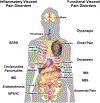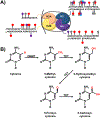Targeting epigenetic mechanisms for chronic visceral pain: A valid approach for the development of novel therapeutics
- PMID: 30393913
- PMCID: PMC7924309
- DOI: 10.1111/nmo.13500
Targeting epigenetic mechanisms for chronic visceral pain: A valid approach for the development of novel therapeutics
Abstract
Background: Chronic visceral pain is persistent pain emanating from thoracic, pelvic, or abdominal origin that is poorly localized with regard to the specific organ affected. The prevalence can range up to 25% in the adult population as chronic visceral pain is a common feature of many visceral disorders, which may or may not be accompanied by distinct structural or histological abnormalities within the visceral organs. Mounting evidence suggests that changes in epigenetic mechanisms are involved in the top-down or bottom-up sensitization of pain pathways and the development of chronic pain. Epigenetic changes can lead to long-term alterations in gene expression profiles of neurons and consequently alter functionality of peripheral neurons, dorsal root ganglia, spinal cord, and brain neurons. However, epigenetic modifications are dynamic, and thus, detrimental changes may be reversible. Hence, external factors/therapeutic interventions may be capable of modulating the epigenome and restore normal gene expression for extended periods of time.
Purpose: The goal of this review is to highlight the latest discoveries made toward understanding the epigenetic mechanisms that are involved in the development or maintenance of chronic visceral pain. Furthermore, this review will provide evidence supporting that targeting these epigenetic mechanisms may represent a novel approach to treat chronic visceral pain.
Keywords: acetylation; brain; gastrointestinal; methylation; spinal cord; stress.
© 2018 This article is a US government work and is in the public domain in the USA.
Conflict of interest statement
Disclosures
The authors declare no conflicts of interest. The views expressed in this review article are those of the authors and do not necessarily reflect the position or policy of the Department of Veterans Affairs or the United States government.
Figures


Similar articles
-
Epigenetic regulation of genes that modulate chronic stress-induced visceral pain in the peripheral nervous system.Gastroenterology. 2015 Jan;148(1):148-157.e7. doi: 10.1053/j.gastro.2014.09.032. Epub 2014 Sep 28. Gastroenterology. 2015. PMID: 25263804 Free PMC article.
-
Targeting Epigenetic Mechanisms for Chronic Pain: A Valid Approach for the Development of Novel Therapeutics.J Pharmacol Exp Ther. 2016 Apr;357(1):84-93. doi: 10.1124/jpet.115.231670. Epub 2016 Jan 19. J Pharmacol Exp Ther. 2016. PMID: 26787772 Review.
-
The Pharmacology of Visceral Pain.Adv Pharmacol. 2016;75:273-301. doi: 10.1016/bs.apha.2015.11.002. Epub 2016 Jan 6. Adv Pharmacol. 2016. PMID: 26920016 Review.
-
Importance of epigenetic mechanisms in visceral pain induced by chronic water avoidance stress.Psychoneuroendocrinology. 2013 Jun;38(6):898-906. doi: 10.1016/j.psyneuen.2012.09.016. Epub 2012 Oct 22. Psychoneuroendocrinology. 2013. PMID: 23084728
-
Epigenetic regulation of persistent pain.Transl Res. 2015 Jan;165(1):177-99. doi: 10.1016/j.trsl.2014.05.012. Epub 2014 May 29. Transl Res. 2015. PMID: 24948399 Free PMC article. Review.
Cited by
-
Upregulation of KDM6B in the anterior cingulate cortex contributes to neonatal maternal deprivation-induced chronic visceral pain in mice.Mol Pain. 2024 May 25;20:17448069241260349. doi: 10.1177/17448069241260349. Online ahead of print. Mol Pain. 2024. PMID: 38795338 Free PMC article.
-
Activation of EphrinB2/EphB2 signaling in the spine cord alters glia-neuron interactions in mice with visceral hyperalgesia following maternal separation.Front Pharmacol. 2024 Sep 3;15:1463339. doi: 10.3389/fphar.2024.1463339. eCollection 2024. Front Pharmacol. 2024. PMID: 39290870 Free PMC article.
-
Injury-Driven Structural and Molecular Modifications in Nociceptors.Biology (Basel). 2025 Jun 29;14(7):788. doi: 10.3390/biology14070788. Biology (Basel). 2025. PMID: 40723348 Free PMC article. Review.
-
N4-acetylcytidine acetylation of neurexin 2 in the spinal dorsal horn regulates hypersensitivity in a rat model of cancer-induced bone pain.Mol Ther Nucleic Acids. 2024 Apr 23;35(2):102200. doi: 10.1016/j.omtn.2024.102200. eCollection 2024 Jun 11. Mol Ther Nucleic Acids. 2024. PMID: 38831898 Free PMC article.
-
Association Between Psychosocial Disorders and Gastroesophageal Reflux Disease: A Systematic Review and Meta-analysis.J Neurogastroenterol Motil. 2022 Apr 30;28(2):212-221. doi: 10.5056/jnm21044. J Neurogastroenterol Motil. 2022. PMID: 35362447 Free PMC article. Review.
References
-
- Woolf CJ, Salter MW. Neuronal plasticity: increasing the gain in pain. Science. 2000;288(5472):1765–1769. - PubMed
-
- Policy. IoMBoHS. Relieving pain in America A Blueprint for Transforming Prevention, Care, Education and Research. The National Academies Press; Washington; D.C. 2011. - PubMed
-
- Drossman DA, Hasler WL. Rome IV-Functional GI Disorders: Disorders of Gut-Brain Interaction. Gastroenterology. 2016;150(6):1257–1261. - PubMed
Publication types
MeSH terms
Grants and funding
LinkOut - more resources
Full Text Sources

